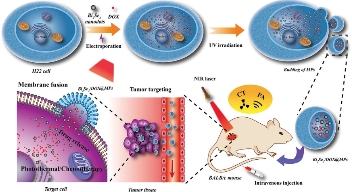On December 12, a research paper entitled “Engineered Cell-Derived Microparticles Bi2Se3/DOX@MPs for Imaging Guided Synergistic Photothermal/Low-Dose Chemotherapy of Cancer” has been published in Advanced Science (IF=15.804), which was performed by Prof. Xiangliang Yang’ and Dr. Jun Hu’s group from National Engineering Research Center for Nanomedicine, College of Life Science and Technology, Huazhong University of Science and Technology.
Cell-derived microparticles, which are recognized as nanosized phospholipid bilayer membrane vesicles, have exhibited great potential to serve as drug delivery systems in cancer therapy. However, for the purpose of comprehensive therapy, microparticles decorated with multiple therapeutic components are needed, but effective engineering strategies are limited and still remain enormous challenges. In this work, Bi2Se3 nanodots and DOX co-embedded tumor cell-derived microparticles (Bi2Se3/DOX@MPs) are successfully constructed through ultraviolet light irradiation-induced budding of parent cells which are pre-loaded with Bi2Se3 nanodots and DOX via electroporation. The multifunctional microparticles are obtained with high controllability and drug loading capacity without unfavorable membrane surface destroy, maintaining their excellent intrinsic biological behaviors. Through membrane fusion cellular internalization, Bi2Se3/DOX@MPs show enhanced cellular internalization and deepened tumor penetration, resulting in extreme cell damage in vitro without considering endosomal escape. Because of their distinguished photothermal performance and tumor homing target capability, Bi2Se3/DOX@MPs exhibit admirable dual-modalimaging capacity and outstanding tumor suppression effect. Under 808 nm laser irradiation, intravenous injection of Bi2Se3/DOX@MPs into H22 tumor-bearing mice results in remarkably synergistic antitumor efficacy by combining photothermal therapy with low-dose chemotherapy in vivo. Furthermore, the negligible hemolytic activity, considerable metabolizability and low systemic toxicity of Bi2Se3/DOX@MPs imply their distinguished biocompatibility and great potential for tumor theranostics.

Prof. Xiangliang Yang and Dr. Jun Hu from Huazhong University of Science and Technology are the co-corresponding authors. PhD candidate Dongdong Wang from Huazhong University of Science and Technology is the first author. This work is supported by the National Basic Research Plan of China and the National Natural Science Foundation of China.
